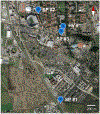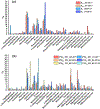Phytosampling-a supplementary tool for particulate matter (PM) speciation characterization
- PMID: 33755885
- PMCID: PMC8713460
- DOI: 10.1007/s11356-021-13292-z
Phytosampling-a supplementary tool for particulate matter (PM) speciation characterization
Abstract
Ambient air particulate matter (PM) and PM-associated environmentally persistent free radicals (EPFRs) have been documented to contribute to pollution-related health effects. Studies of ambient air PM potentially bear artifacts stemming from the collection methods. We have investigated the applicability of PM phytosampling (PHS) as a supplementary tool to a classic PM sampler in respect of achieving better PM chemical composition assessment (primarily organic fraction). Phytosampling is a static PM collection method relying on the particle entrapment by the plant's leaf through electrostatic forces and surface trichomes. We have investigated the differences in the EPFR and polycyclic aromatic hydrocarbon (PAH) speciation and concentration on ambient air PM for PHS and high-volume PM sampler (HVS). The advantages of PHS are easy particle recovery from the matrix, collection under natural environmental conditions, and the ability to apply a dense collection network to accurately represent spatial pollutant distribution. The experimental results show that the PHS can provide valuable speciation information, sometimes different from that observed for HVS. For PM collected by PHS, we detected the larger contribution of oxygen-centered EPFRs, different decay behavior, and more consistent PAH distribution between different PM sizes compared to the PM from HVS. These results indicate that the isolation of samples from the ambient during HVS sampling and exposure to high-volume airflow may alter the chemical composition of the samples, while the PHS method could provide details on the original speciation and concentration and be more representative of the PM surface. However, PHS cannot evaluate an absolute air concentration of PM, so it serves as an excellent supplementary tool to work in conjunction with the standard PM collection method.
Keywords: Environmentally persistent free radicals; High-volume PM sampler; PM0.1; PM2.5; Particulate matter; Phytosampling; Polycyclic aromatic hydrocarbons.
© 2021. The Author(s), under exclusive licence to Springer-Verlag GmbH Germany, part of Springer Nature.
Conflict of interest statement
Figures









References
-
- Azimi P, Zhao H, Fazli T, Zhao D, Faramarzi A, Leung L, Stephens B (2018) Pilot study of the vertical variations in outdoor pollutant concentrations and environmental conditions along the height of a tall building. Build Environ 138:124–134. 10.1016/j.buildenv.2018.04.031 - DOI
MeSH terms
Substances
Grants and funding
LinkOut - more resources
Full Text Sources
Other Literature Sources

